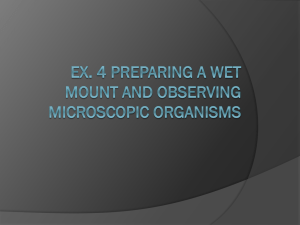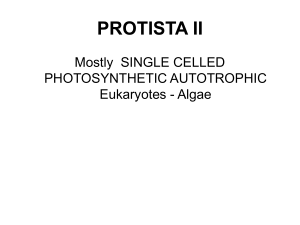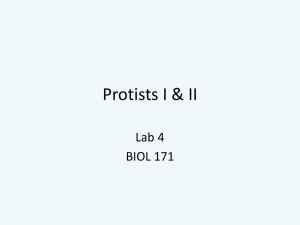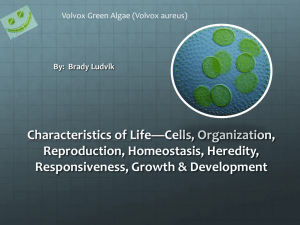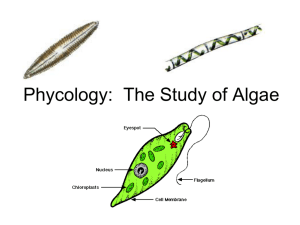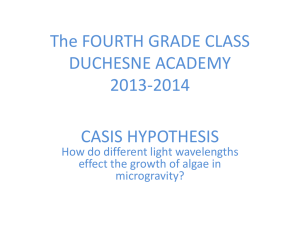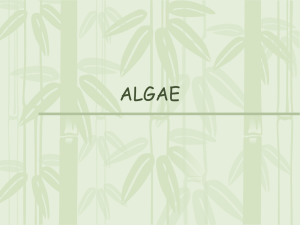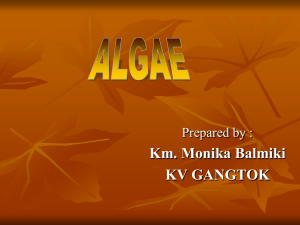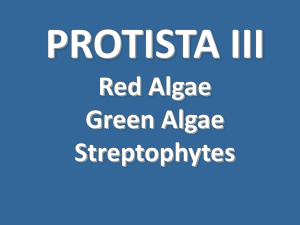Lab 4 – Protists 2 - How Biology Works
advertisement
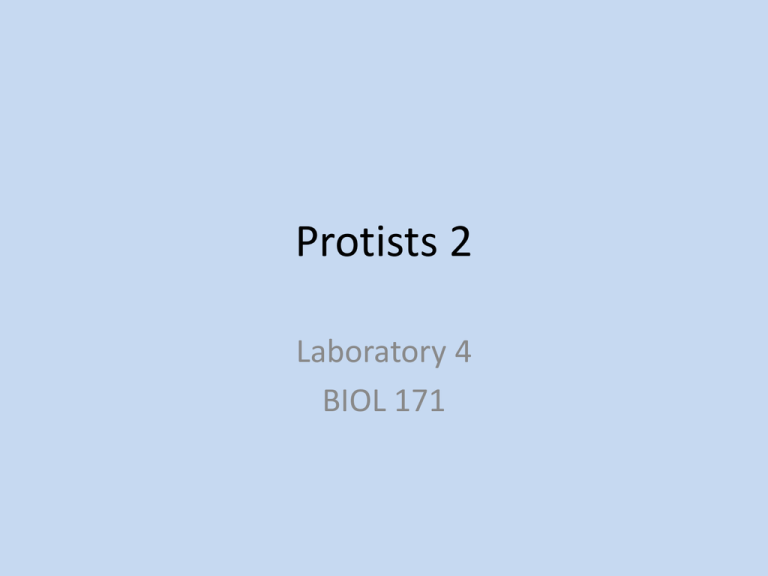
Protists 2 Laboratory 4 BIOL 171 Lab Study 3A: Amoebozoans Amoeba proteus • Pseudopodia – temporary extensions of amoeboid cells, function in moving and engulfing food Slime Molds (Mycetozoa) (again) • Protists which use spores to reproduce • Heterotrophic – requires carbon in organic form, cannot manufacture it’s own • Feed using phagocytosis • Suggests they descended from unicellular amoeba-like organisms • Two types: plasmodial and cellular (we will be observing plasmodial type today) Physarum (slime mold) • Plasmodial stage – vegetative stage that consists of a multinucleate mass of protoplasm (no cell walls), enormous single cells with thousands of nuclei – Form when individual flagellated cells swarm together and fuse – Feeds on bacteria, detritus, fungi, and other slime molds as it creeps along the surface of moist logs or dead leaves • Fruiting bodies – sporangia – Reproductive structures that produce spores – Life cycle similar to fungi Slime Mold Life Cycle Lab Study 4A: Red Algae (Rhodophyta) • • • • Eukaryotic Photosynthetic NOT plants Most are aquatic What are red algae? • Simplest is single-celled, but most have a macroscopic, multicellular body form • Autotrophic (photosynthetic)– manufactures its own organic nutrients from inorganic carbon sources • Contain chlorophyll a and accessory pigments phycocyanin and phycoerythrin • Why red? Because these pigments allow red algae to photosynthesize and live at greater depths than most other algae. • Not all are red! Many green, black, even blue, depending on the depth in the ocean they grow A quick note on pigments – How do they work? (Why are red algae red?) 1) Photons from the sun excite pigment molecules. 2) These pigments transform the energy into electrons (using water) and “pump them up” to form NADPH – a molecule that carries energy to the next step of photosynthesis. - there will be more on this when we get to plants! Living Specimens Porphyridium Preserved specimens Porphyra coralline algae Chondrus crispus Porphyra life cycle both sexual and asexual – alternation of generations! Coralline algae – “living rock” • Extremely important role in the ecology of coral reefs: sea urchins, fish, and mollusks eat them (herbivore enhancement). • Create microhabitats that protect invertebrates from predation. • Cell walls composed of calcium carbonate – this allows it to fossilize • Economic importance: soil conditioners, food additive for livestock, water filtration, medical vermifuge (stopped late in 18th century), preparation of dental bone implants Economic Uses • Agar – polysaccharide extracted from the cell wall of red algae, used to grow bacteria and fungi • Carrageenan – extracted from red algae cell walls, used to give the texture of thickness and richness to foods such as dairy drinks and soups. • Porphyra (or nori) – seaweed wrappers for sushi, billion-dollar industry! Lab Study 4B: Green Algae (Chlorophyta) • unicellular motile and non-motile, colonial, filamentous, and multicellular – GREAT DIVERSITY • Live primarily in freshwater • Share many characteristics with land plants – Storage of starch, presence of chlorophylls a and b, photosynthetic pathways, and organic compounds called flavonoids • Most botanists support the hypothesis that plants evolved from green algae Living Specimens Chlamydomonas Volvox Pediastrum Closterium Pandorina Volvox Daughter colonies Preserved Specimens Ulva Chara Table 4: Representative Green Algae (pg. 72) Name Body Form Spirogyra Filamentous Ulva Leaf like Chara Branched Chlamydomonas Pandorina Unicellular flagellate Aggregate Volvox Colony (flagellate) Pediastrum Non-motile colony Closterium Non-motile single celled Characteristics 3A: Amoebozoans Amoeba proteus Physarum Dictyostelium 4A: Rhodophyta: Red Algae Porphyridium (living) Polysiphonia (preserved or living) Chondrus crispus (preserved) Porphyra (preserved) Coralline algae (preserved/ set) Nori 4B: Chlorophyta: Green Algae Chlamydomonas (living) Pandorina (living or prepared) Volvox (living) Pediastrum (living) Closterium (living) Spirogyra (living) Spirogyra (prepared slides) Ulva (preserved) Chara (preserved or live) Here’s the list for today! And.... Our own protist samples!
